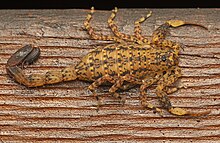
Uropygi is an arachnid order comprising invertebrates commonly known as whip scorpions or vinegaroons. They are often called uropygids. The name "whip scorpion" refers to their resemblance to true scorpions and possession of a whiplike tail, and "vinegaroon" refers to their ability when attacked to discharge an offensive, vinegar-smelling liquid, which contains acetic acid. The order may also be called Thelyphonida. Both names, Uropygi and Thelyphonida, may be used either in a narrow sense for the order of whip scorpions, or in a broad sense which includes the order Schizomida.

Gasteracantha is a genus of orb-weaver spiders first named by Carl Jakob Sundevall in 1833. Species of the genus are known as spiny-backed orb-weavers, spiny orb-weavers, or spiny spiders. The females of most species are brightly colored with six prominent spines on their broad, hardened, shell-like abdomens. The name Gasteracantha is derived from the Greek gaster (γαστήρ), meaning "belly, abdomen", and akantha (άκανθα), meaning "thorn, spine". Spiny-backed orb-weavers are sometimes colloquially called "crab spiders" because of their shape, but they are not closely related to the true crab spiders. Other colloquial names for certain species include thorn spider, star spider, kite spider, or jewel spider.

Cosmophasis is a genus of spiders in the family Salticidae. They are predominantly Southeast Asian, while some species occur in Africa and Australia. Although most species more or less mimic ants, there are also colorful species that follow a different strategy.

Zenodorus is a genus of the jumping spiders distributed from the Moluccas to Australia, including several islands of the Pacific. It was once considered a junior synonym of Omoedus, but this was later rejected by Jerzy Prószyński in 2017. At least one species, Z. orbiculatus, specializes on hunting ants.

Argyrodes, also called dewdrop spiders, is a genus of comb-footed spiders that was first described by Eugène Louis Simon in 1864. They occur worldwide, and are best known for their kleptoparasitism. They can spin their own webs, but tend to invade and reside in their hosts' webs. This relationship can be commensal or even mutual if the dewdrop spider feeds on small trapped insects that are not eaten by the host. Some species can even prey upon the host.

Heteropoda is a genus of spiders in the family Sparassidae, the huntsman spiders. They are mainly distributed in tropical Asia and Australia, while at least one species, H. venatoria, has a cosmopolitan distribution, and H. variegata occurs in the Mediterranean.
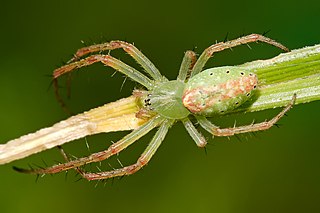
Cyrtophora, the tent-web spiders, is a genus of orb-weaver spiders first described by Eugène Simon in 1895. Although they are in the "orb weaver" family, they do not build orb webs. Their tent-like, highly complex non-sticky web is sometimes considered a precursor of the simplified orb web. These webs are aligned horizontally, with a network of supporting threads above them. These spiders often live in colonies. Females have a body length of mostly about 10 millimetres (0.39 in) long. Some members, including Cyrtophora cicatrosa, exhibit the ability to change colour rapidly.

Arachnura, also known as drag-tailed spider, scorpion-tailed spider and scorpion spider, is a genus of orb-weaver spiders that was first described by A. Vinson in 1863. They are distributed across Australasia, Southern and Eastern Asia with one species from Africa. Females can grow up to 1 to 3 centimetres long, while males reach only 2 millimetres (0.079 in) long. The name is a combination of the Ancient Greek "arachne-" (ἀράχνη) and "uro" (οὐρά), meaning "tail". The tails are only present on females, but unlike the common names suggests, these spiders aren't related to scorpions. They curl up their tails when disturbed, but they are completely harmless. Bites are rare, and result in minor symptoms such as local pain and swelling. They stay at the middle of their web day and night, and their bodies mimic plant litter, such as fallen flowers, twigs, or dead leaves.

The marbled frog or marbled marsh frog is a species of ground-dwelling frog native to northern and north-eastern Australia, and southern New Guinea in both Indonesia and Papua New Guinea.

The Buthidae are the largest family of scorpions, containing about 100 genera and 1339 species as of 2022. A few very large genera are known, but a high number of species-poor or monotypic ones also exist. New taxa are being described at a rate of several new species per year. They have a [cosmopolitan] distribution throughout tropical and subtropical environments worldwide. Together with four other families, the Buthidae make up the superfamily Buthoidea. The family was established by Carl Ludwig Koch in 1837.
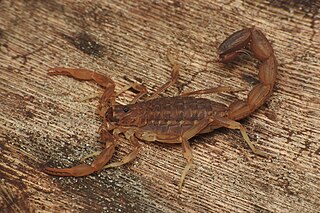
Lychas srilankensis is a species of scorpion in the family Buthidae. It is endemic to Sri Lanka.

Anepsion is a genus of orb-weaver spiders first described by Embrik Strand in 1929.

Tylorida is a genus of long-jawed orb-weavers that was first described by Eugène Louis Simon in 1894.

Hormurus is a genus of scorpions, commonly known as rainforest scorpions, in the family Hormuridae, that occur in rainforest habitats, mainly in Australia and Melanesia. The genus was first described by Swedish arachnologist Tamerlan Thorell in 1876.
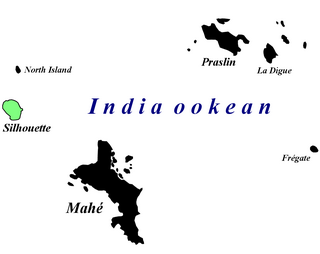
Afrolychas braueri, commonly known as the Seychelles forest scorpion, is a species of scorpion in the family Buthidae. It is currently thought to survive only on Silhouette Island, Seychelles, although the species was historically found on two additional Seychellois islands. This scorpion lives in leaf litter in forests that are largely unaffected by invasive plant species. It is a small yellowish-brown scorpion with three prominent keels on the dorsal surface of its mesosoma, which distinguishes it from other scorpions. While not much is known about the Seychelles forest scorpion's ecology due to the paucity of sightings, it is known to rely solely on its venom to capture its prey and defend its young. Its venom is not dangerous to humans.
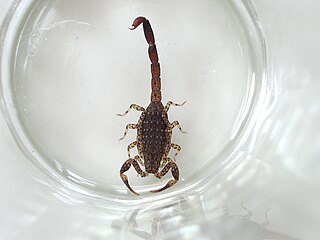
Lychas is a genus of scorpions belonging to the family Buthidae. It is one of the most widespread genus of the scorpions, where the species are found throughout in Africa and Seychelles, and in the Oriental region from India to Melanesia.
Lychas buchari, also known as the yellow sand scorpion or Buchar's scorpion, is a species of small scorpion in the Buthidae family. It is native to Australia, and was first described in 1997 by Czech arachnologist Frantisek Kovarik.

Lychas marmoreus, also known as the marbled scorpion, little marbled scorpion or bark scorpion, is a species of small scorpion in the Buthidae family. It is native to Australia, and was first described in 1845 by German arachnologist Carl Ludwig Koch.
Marbled scorpion may refer to various Australian scorpions, including:

